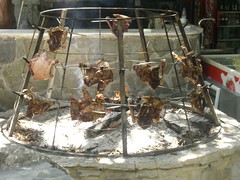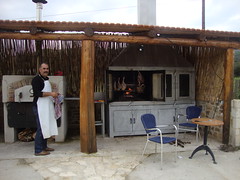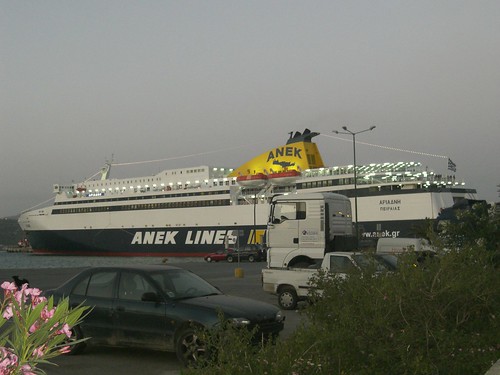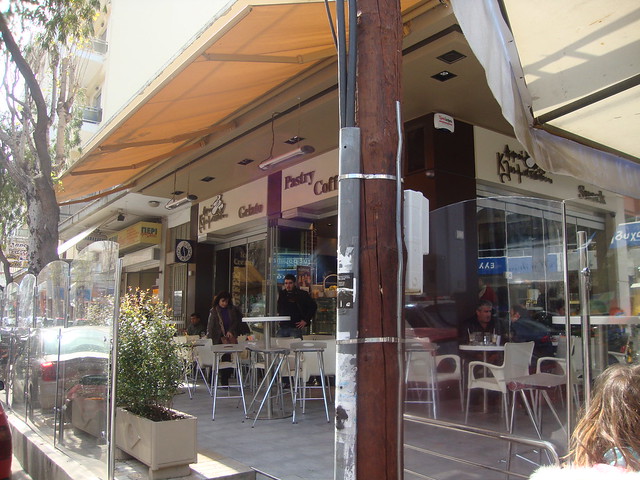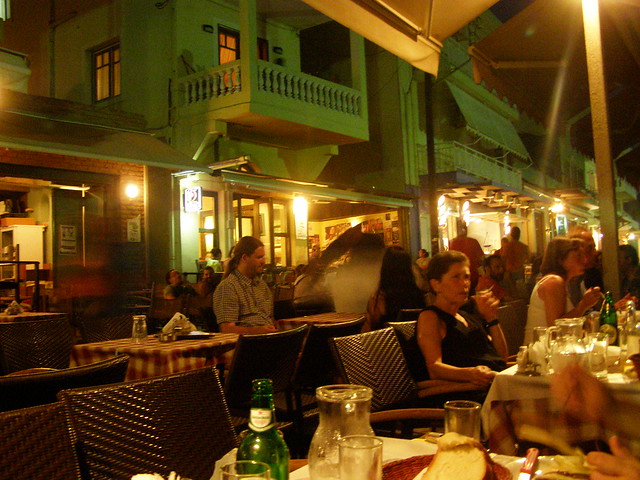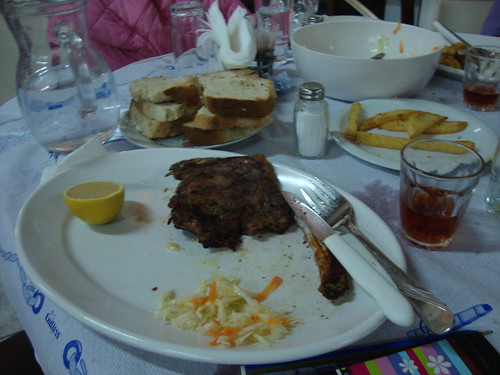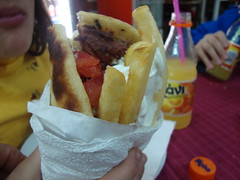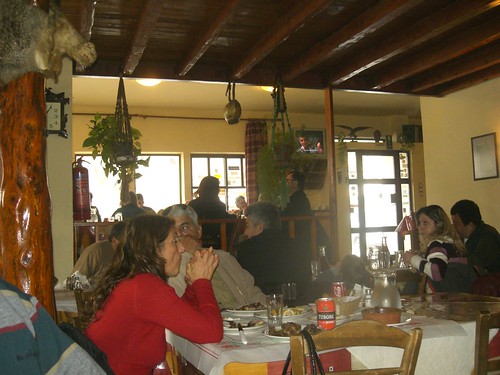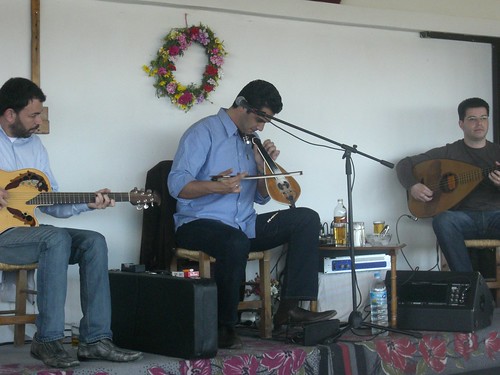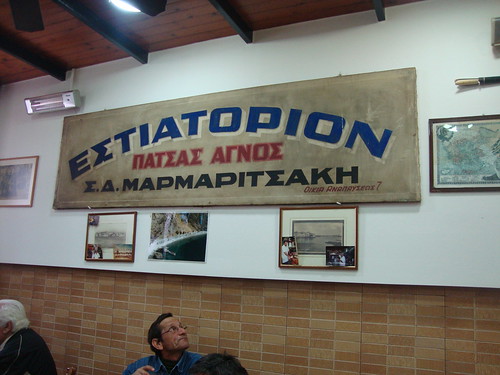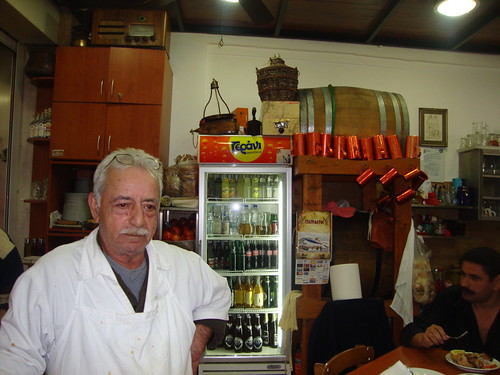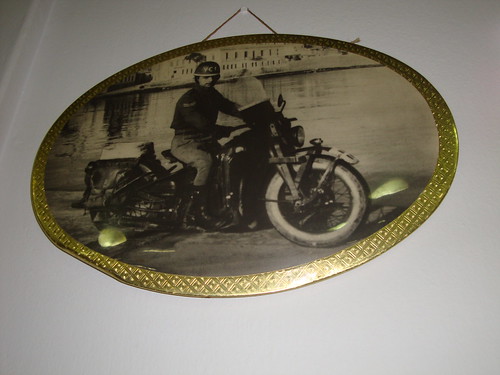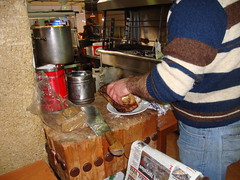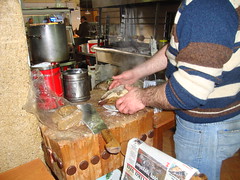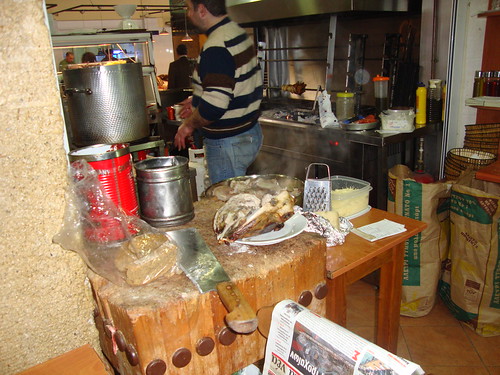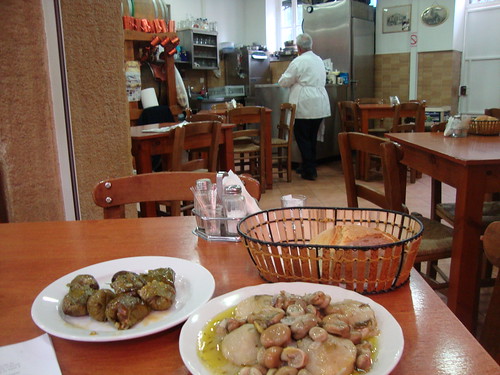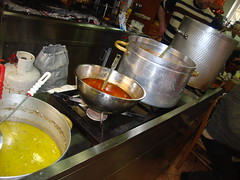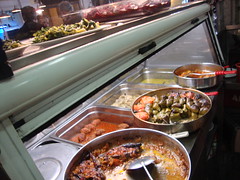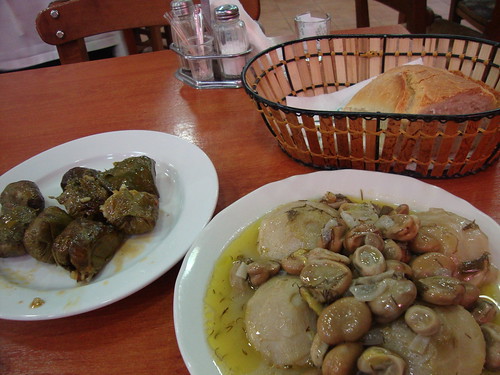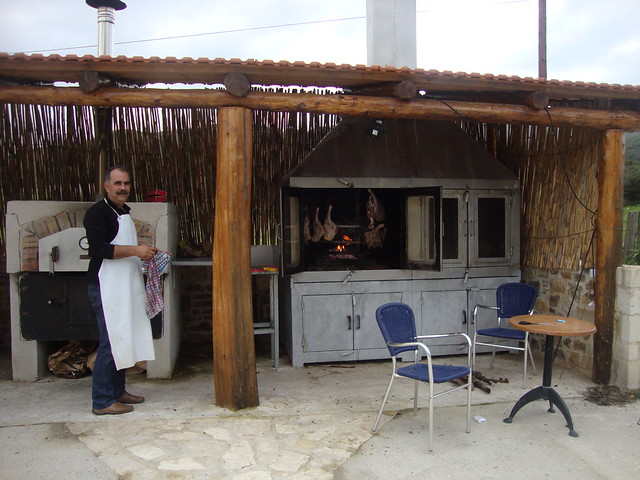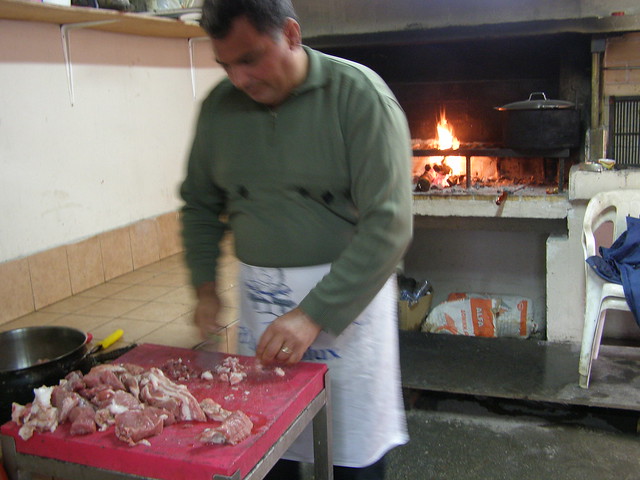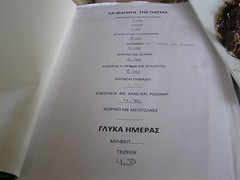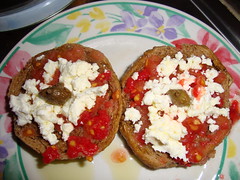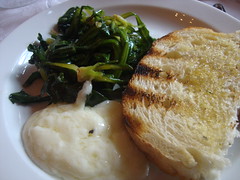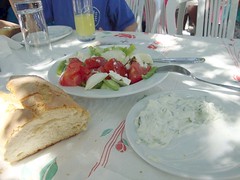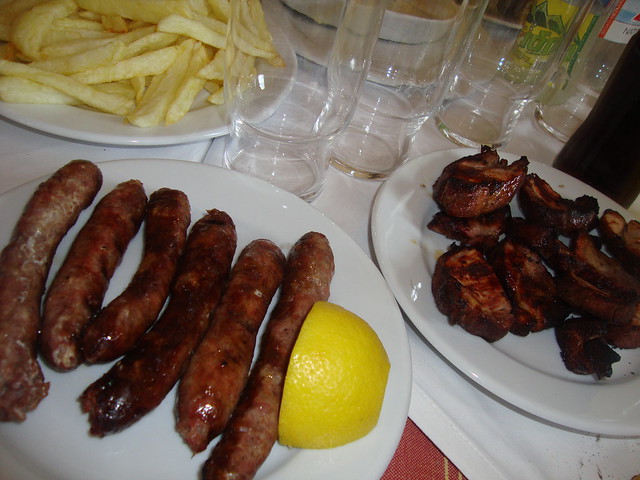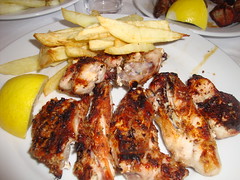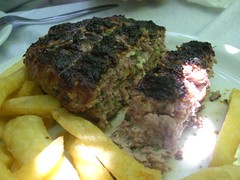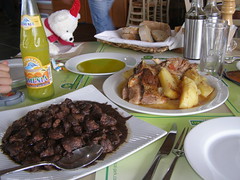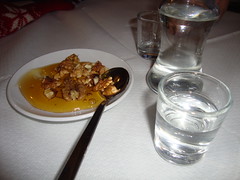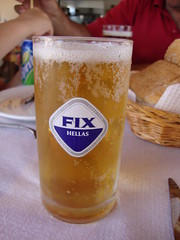If certain discussion topics about Cretan cuisine are not pointed out to me, I would take them for granted. For instance, ordering a meal at a Cretan taverna (highlighted by a reader*) sounds like stating the obvious: you enter the taverna seating area, choose your table, sit down, take out the list you wrote back at home of your favorite meals from Organically cooked, find them on the menu card and order them. Then it occurred to me that whenever I go out for a meal at a taverna, I don't usually look at the menu card. So, the question is: how can you be sure of ordering a good meal in a Cretan taverna? My husband is the expert here, so I leave you in his trusted care...
Day and time: To enjoy a good meal, you need to have the appropriate weather. The best time of year to enjoy a meal out is when the weather is good but it isn't quite summer yet. That doesn't have anything to do with tourism; tourists usually go to places with a good view, so they don't usually go to the kinds of places I like to go to. If it's too hot, you don't really feel like eating; if it's too cold, you eat to warm up, so you may not really be enjoying your meal. I also hate going out for a meal on a public holiday. You need to get to the place early to grab a table, you need to wait for a long time till your order comes, the food won't be cooked to perfection because there are too many people wanting to eat at the same time, the ingredients won't be that good, either, for the same reasons, and there will be too much cacophony. I like going to a taverna at midday, not in the evening, because that's when I like to have the biggest meal of the day, at lunchtime, not dinnertime. I'd never go to a mountain taverna at the weekend after snow has fallen. It's every man and his dog then. All you'll remember of the trip is how long it took you to get back home because everyone blocked the road with their big cars.
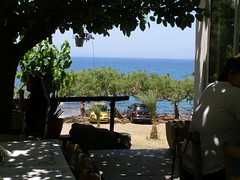
 Summertime by the sea (Waves on the rocks at Ravdoucha), wintertime in the mountains (Drakoulakis at Omalos): Crete has something for everyone all year round. Tourists generally aren't catered for from November to March, but private groups and individuals come to Crete, and they are never disappointed - as long as it's not raining, autumn, late winter and early spring are the best times to visit to Crete if swimming isn't your main aim.
Summertime by the sea (Waves on the rocks at Ravdoucha), wintertime in the mountains (Drakoulakis at Omalos): Crete has something for everyone all year round. Tourists generally aren't catered for from November to March, but private groups and individuals come to Crete, and they are never disappointed - as long as it's not raining, autumn, late winter and early spring are the best times to visit to Crete if swimming isn't your main aim.
The seaside taverna: I'm not a seaside taverna kind of person. If you want to eat by the seaside, you've got to be prepared to pay for it. That's why you go to the seaside, for the view. You pay for the view, not the food. You might want to go to the seaside to eat out if you want to eat fresh fish. But to eat fresh fish, you've got to be prepared to pay for that, too, because fish is the most expensive meal you can buy at a taverna. I like to go to a seaside taverna in the summer, and preferably in the evening. Who wants to burn under the sun? Seaside tavernas are for tourists. They won't be asking if the calamari is frozen; they just want to eat calamari. If I have to go to the seaside for a meal out, I choose places that offer lots of shade. Most likely, I'll be on holiday by the sea, which is why I'll go to a seaside taverna. But I won't order fish because it's just too expensive. I'd probably order calamari which is reasonably well-priced, which we don't eat at home all the time, and a plate of αχινούς (ahinous - sea urchins), which we only eat when we go out. That's a special dish, which is why I'd order it at a seaside taverna.
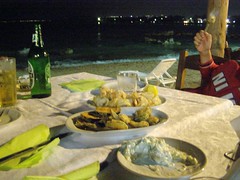
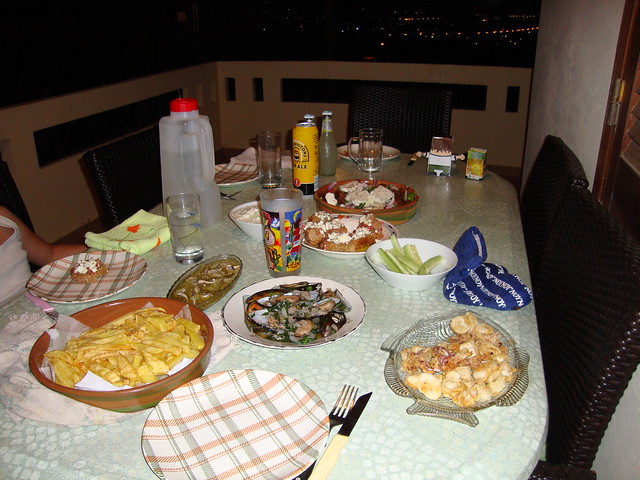
It's relatively cheap to eat out at a place like this (Kalamaki taverna at Kalamaki beach), the perfect place to be on a summer's evening. But it's not something locals can do every day - thank goodness for good home cooking and a roomy balcony, like ours. If I really want to eat fish, I would eat it in the Agora in central Hania, where fish is cooked freshly on a daily basis when the market is open. It many not be next to the sea, but the people-watching entertainment is priceless.

The countryside taverna: I prefer to go to the countryside for a meal out, which invariably means good meat raised in the area where you choose to go out for a meal. It's likely to be cheap too, because
the owner of the taverna is probably raising most of his ingredients himself. The countryside is usually quiet and peaceful, you're surrounded by natural landscape, most of the food will have been raised in the same area where you're eating it, and the chief cook will probably be from the area, probably a woman, so she'll know how to cook the traditional dishes very well. And that's what I want when I go out for a meal:
traditional Cretan food, food that I know well, cooked with the best ingredients in the way I've come to know and love it. These sorts of places are really well priced. We never pay more than 11-12 euro a person when we go out, and we never feel hungry after our meal. The decor is unimportant at places like this; they're probably situated amongst beautiful landscape. Who needs indoor decor when you're surrounded by Cretan wilderness?
Getting a feel for what is cooking is always an educational experience in countryside tavernas in Crete: wood-fired ovens and barbecues are the norm. Left: Fragma taverna in Rethimno, which specialises in antikristo, an upright BBQ. Right: Botanical Garden Restaurant on the Fournes road past Omalos.
The choice of taverna: I hardly ever go to a taverna that I don't know well, or haven't been told about. Wherever I go, it's always
συστημένος; a colleague will have been there and told me about the place. So I usually know what to expect from most places before I go there. Every now and then, when I find myself in the position of having to choose an unreviewed taverna, the first thing I do is park the car and tell the family to come with me to find out what the taverna's offering (the wife never wants to accompany me when I do this). I head towards the kitchen to see what's cooking. Decor, location, bathrooms, tableware, none of that's going to tell you whether the food's good. You have to go into the kitchen and see what's in the pots or the ovens. If you don't get the chance to see what's in them, at least you'll be able to smell them. At this stage, you might end up talking to the frontpeople at the taverna. I ask them what's in the pots and pans. If it sounds like the food I want to eat, then I tell the wife and kids to choose a table (they're usually waiting for me in the car, anyway).
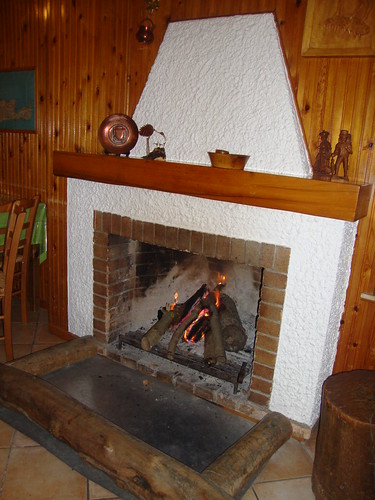
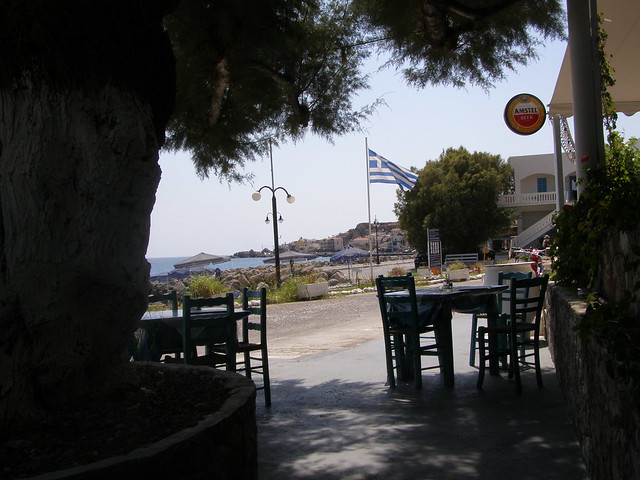 A fireplace in the winter (Drakoulakis at Omalos), a shady spot near the sea in the summer: Crete at its best.
A fireplace in the winter (Drakoulakis at Omalos), a shady spot near the sea in the summer: Crete at its best.: Steer clear of fireplaces; even in the winter, it's usually too hot to sit very close to it. I only sit outdoors in July and August. Or during a heatwave. And always in the shade. Never near a door, because it'll open and close all the time and creates draughts.
The typical Greek taverna menu is broken up into appetisers, salads, mains cooked in the oven and grilled dishes, what Greeks call 'της ώρας' because they're cooked on order (top left: To Kima, Paleohora). Specials may be written on a separate piece of paper (top right: Botanical Garden Restaurant), or they may be communicated to the guests (bottom left: Leventis, Therisso). Menus in tourist areas are invariably written in the global style on a chalkboard (bottom right: Paleohora).
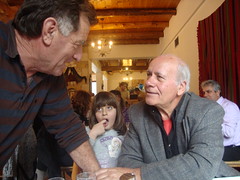
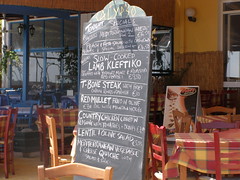
The menu card: I never look at a menu card. I always ask the waiter to tell us what's on offer. I grew up at a time when we listened more than we read. I'm used to getting the menu told to to me. Sometimes, the menu card lists dishes that aren't available, so what's the point of seeing a menu card? Tavernas sometimes have a specialty of the area that they don't always write on the menu. It's something that they'll tell discerning customers about, things that are only available in small quantities, which is why they'll only tell you about them if you ask them. Tavernas that use meat raised by the owners do things like fried liver and sweetbread from freshly slaughtered meat, but there's not enough to go round, so they might be keeping it for their regular customers. But they'll tell you if you ask for it.
Cretan appetisers make up a complete meal of themselves. I prefer vegetarian meals, so I don't need much more to eat than a selection of these salads and dips.
The more carnivorous among us need not feel left out. Left: country-style sausages (loukanika) and smoked pork (apaki); right: grilled rabbit.
Salads and appetisers: I love tomato salad, but tomato is only really good in summer; I never order a tomato salad once the tomato season is over. Even then, I still don't order tomato salad much at a taverna, because I - we, my whole family - loves horta. I grow vlita in the summer, but I can't get enough of them, so I'll still order them at a taverna. In the winter, I always order stamnagathi. I just want something to go with my meat, not to be eaten instead of them. Salads always require a lot of olive oil too, so you end up dipping your bread into the salad all the time. I don't like my salads to be too creative, otherwise they become a complete meal, and I'll have eaten too much before the main meat dishes arrive at the table, so I don't see the point of ordering too much salad. Besides, we eat a lot of salads and horta at home; most of the time, I've grown them myself. What's the point of paying for salad at a taverna? Same applies to all those mezedakia, like apaki and loukanika (sausages). I like kalitsounia and dakos, but I don't need to order them at a taverna; we eat all that at home on a regular basis! I let kids order what they want, but I know it's not the cleverest idea to allow them to have so many appetisers at a taverna, because they'll feel too stuffed to eat some of the mains dishes. They're kids; they'll learn. I'll make an exception for staka in the winter, which we never eat at home. Tzatziki is great in the summer, but only just enough to go with your meat. Too much of any of those, and I won't be able to enjoy my meat. I'll be eating bread instead. I make an exception to french fries, as long as they're not προ-κατ; they are usually freshly cut and freshly fried at good tavernas, and the taverna is most likely to be cooking their own harvest. But I'd much rather have fried courgette and aubergine chips in the summer.

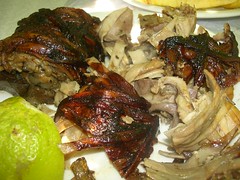
Meat specialties abound in Crete: my photos don't do it justice; tsigariasto (goat cooked in oil), kokoretsi (roast intestines and offal on the spit), roast potatoes and pork cooked in blood, stuffed bifteki (hamburger).
The main course: A Cretan countryside taverna offers a standard menu. I already know what it will be offering. That's what I go for, I know what I want to eat: roast lamb with potatoes, tsigariasto (goat cooked in the tradition of Sfakia), avgolemono lamb or goat, roast pig, well-grilled pork steaks, rooster in wine sauce. Each taverna might offer a signature dish of their own, which I might try. I can remember eating grilled rabbit - it tasted like tender barbecued chicken, it was fantastic. So was the roast lamb stuffed with mizithra. It's all to do with the ingredients: if they aren't good to start with, then the food won't be. If I don't go to a countryside taverna or I'm less sure of the ingredients, then I choose general Greek cuisine. You can't go wrong with makaronada, bifteki or pastitsio, because these dishes are made fresh daily. I personally would never choose boureki and yemista, because I eat plenty of that at home. When I go out for a meal, I eat meat, not vegetables!
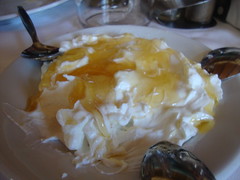
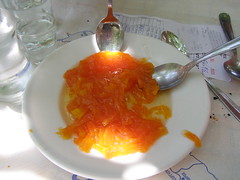
Dessert in a Cretan taverna is usually on the house: it can be traditional, like yoghurt with honey or a syrupy spoon sweet...
 ... or more complicated with Sfakianes pites (cheese and honey pies), which are menu choices, so they need to be ordered (and paid for. In the summer, fresh locally grown watermelon is usually served.
... or more complicated with Sfakianes pites (cheese and honey pies), which are menu choices, so they need to be ordered (and paid for. In the summer, fresh locally grown watermelon is usually served.
Dessert: Dessert? You don't order that, do you? That comes at the end of the meal, on the house. At any rate, you'll be too full to eat dessert by then. If there's enough room, you can order Sfakianes
pites. But that's about all: dessert is unnecessary after a rich meal. All you need is a nip of tsikoudia.
This is pretty much what we drink when we go out. Cretan fare is simple in essence; we don't complicate it with bottled wines.
Drinks: I like wine, and it's usually good at tavernas, because, again, the owner is probably making his own. I never buy bottled wine. Apart from the prices of bottled wine, I don't like drinking wine which I know has additives to get the taste and colour right. Home-made wine, the kind that our tavernas here always serve, taste just like the wine I drink at home, which is older than a decade, and was allowed to ferment naturally in a wooden barrel. Bottled wine can be good, but I don't really feel the need to order it. Bottled wine is what raises the price of a meal. You can ask the owner to taste both the red and white house wine on offer at the taverna and choose which one you prefer. I like beer too, but it only really goes well with grilled meat, especially in the summer. We let the kids order a fizzy drink when we go out, as it's their occasional treat. But we always ask the waiter to bring the drinks with the food, because kids are kids, and they'll drink it before they even take their first bite.p
Crete in spring or at Easter is one of the best times to visit the island, but most people come in the summer. If you are coming to Crete during the hotter season, check out my summer food post specially written for tourists,
Taste Crete.
*Because of the sheer volume of photographs I upload, it's easier to view them on my facebook page (if you have a facebook account, click 'Like'). My food photographs chronicle my husband's advice: these are my family's rules when we go out for (usually) lunch. Our taverna food choices (with a heavy bias towards meat) reflect the Cretan style of eating out, which differs from the summertime tourist's choices. Vegetarians need not fear - Greek cuisine fully caters for the non-carnivore!
©All Rights Reserved/Organically cooked. No part of this blog may be reproduced and/or copied by any means without prior consent from Maria Verivaki.






